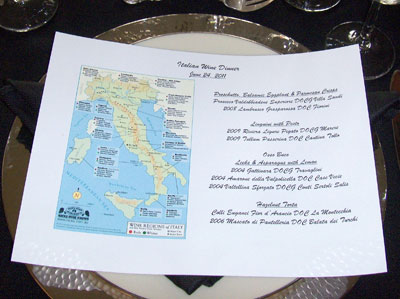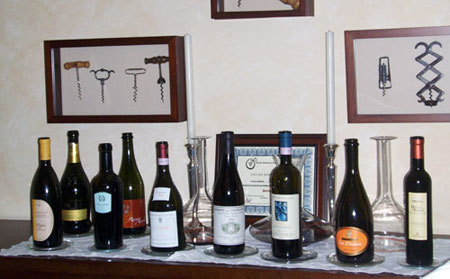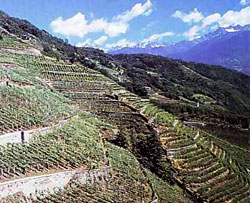 “So, Gary, what was your favorite wine of the night?”
“So, Gary, what was your favorite wine of the night?”
It was about 11:15 and dinner had been over for about forty-five minutes, but no one had left the table.
Our guests had been drinking water and nibbling on three types of chocolate in a desperate attempt to get back in driving condition before heading home. It was at this point that I thought we should hear which of the nine wines we served were the favorites.
“I liked the Pigato and the Gattinara but the Sforzato kept getting better and better. Maybe that one.”
The dinner was in part my personal graduation exercise after completing a fairly intensive Italian wine class given by the North American Sommelier Association, which is the only United States Sommelier Association affiliated with Associazione Italiana Sommelier, Italy’s premier sommelier society. My wife, Peggy, had talked me into taking the course because of an ever growing interest in Italian wines that took hold after a trip to Tuscany about two years ago. When the class was over and I had rather surprisingly passed the exam, Peggy thought we should have a dinner party to show off what I had learned. Since we hadn’t had a real dinner party in about 10 years, even though Peggy is a fantastic cook, it seemed like a good idea.
“Wendy, what about you?”
“I really like the Lambrusco. I’ve never had a sparkling red wine before. I also like the Pigato and the sparkling dessert wine. The reds were all good too.”
“Is she allowed to pick 6 wines as her favorite?” someone asked. “Why not?” seemed to be the consensus. It had become that kind of night, which really is the best kind of night.
 Peggy and I decided that we wanted a menu that would highlight certain regions of Italy to pair with wines from those regions and would still allow her time to attend the party, and not be cooking while everyone else was eating and drinking. (Apparently, she felt that if we give a dinner party once every 10 years, she shouldn’t spend all of it in the kitchen. Peggy can be demanding that way.)
Peggy and I decided that we wanted a menu that would highlight certain regions of Italy to pair with wines from those regions and would still allow her time to attend the party, and not be cooking while everyone else was eating and drinking. (Apparently, she felt that if we give a dinner party once every 10 years, she shouldn’t spend all of it in the kitchen. Peggy can be demanding that way.)
As we talked about what we should serve, we decided on 4 courses to justify tasting 8 different wines, though in the end I added a ninth wine because I just couldn’t choose between two of the reds. To start we went with a simple antipasti that was plated before we sat with food from the region of Emilia-Romagna. Emilia-Romagna is not known so much for its wines as its food, but its foods are some of the most famous in all of Italy: Prosciutto di Parma, Balsamic Vinegar and Parmigiano-Reggiano cheese. Peggy made Parmigiano-Reggiano crisps and we bought the Prosciutto di Parma and a balsamic eggplant from La Bottega Marino in Larchmont Village near where we live. (Peggy generally doesn’t like to serve store bought items, but if you can get the balsamic eggplant from La Bottega Marino, don’t bother to cook as you won’t make it as well as they do.)
Probably the best known wine from Emilia-Romagna is Lambrusco so we served it with the antipasti and continued to pour a fantastic Prosecco Valdobbiadene Superiore that greeted our guests as they arrived and was loved by all. Lambrusco has gotten a bad rap over the years because in the past the only ones that could be found in the U.S were extremely sweet and very cheaply made wines, but in the last several years, the quality of Lambrusco that is being imported to the U.S. has radically improved. The best Lambruscos are bone dry, high-acid sparkling wines that can cut the fat of the fattiest cured meat and cheese plate. It was one of the stars of the night.
“Pen?”
“I think the Passerina reminded me a bit of a Chardonnay with its fullness. I think that’s my choice, but I like the reds and the sparkling desert wine as well”. By this point I was feeling pretty good with the wine choices, since for the most part, I had tried to pick wines that no one had tried and with luck had never even heard of. So with Pen’s vote for the Passerina, 7 of the 9 wines we served already had received a vote.

The second course (the “primi” course for an Italian dinner) was linguini with pesto. Peggy had to spend a few minutes in the kitchen since the pasta needed to be cooked and tossed with the pesto immediately before serving, though she had made the pesto earlier in the day. She had purchased some fresh pasta from Cube, a fantastic little restaurant that sells specialty Italian food items and makes their pastas fresh for the restaurant and for sale.
Pesto is made all over Italy, and some claim that it can be tracked to the region of Liguria. Whether this is true or not, there is no doubt that great pesto is made in this northwestern coastal region, and it pairs perfectly with one of Liguria’s most distinctive wines, Pigato, the wine that made the most favorite lists. The second wine we served with the primi was a Passerina that came from Umbria, and was chosen mostly because it was so different from the Pigato. Where Pigato is very crisp with a little saltiness from the sea that its vines often overlook – some Pigato vines may have the best views in Italy – the Passerina is from Umbria, the only region in Italy that touches neither another country nor the sea. The Passerina was a more rounded, fuller-bodied wine, with less acid and therefore less crispness than the Pigato. A very different style, but still excellent.
The third course (the “secondi”) was logistically the most challenging. We had told everyone on arriving that they may be called upon to help with the plates and glasses (Gary requested an early course “while I still know I can be of some help”), so I asked Stan to help with this one. Stan is the co-founder of Valerie Confections, an amazing producer of chocolates, petit fours, vintage and modern cakes and jams, but it was his long (but not) lost waiter skills that were needed now, for not only were we clearing the second course, we were clearing 32 wine glasses and setting out 24 more. Once the glasses were in place, Stan and I poured the 3 red wines, which I had decanted a few hours earlier.
While Stan was showing off his waiter skills, Peggy was serving the secondi, an osso buco of veal shank with a vegetable of sautéed asparagus and leeks with lemon. It was a great dish for the party not only because Peggy makes an incredible osso buco (with a nod to Suzanne Goin’s Sunday Suppers at Lucques cookbook), but because the best osso buco should be made at least a day ahead as the richness of its flavors and the intensity of the sauce need a bit of time to develop.
Osso buco is a northern Italian dish and needs to be paired with a big red wine. The most famous of the Northern Italian reds are Barolos and Barbarescos from Piemonte, but I didn’t want to serve these as most of the guests had tried them before, so I went farther north, though still in Piemonte, and served a Gattinara, a little known wine that is made with the same grape varietal as Barolo and Barbaresco, the nebbiolo grape.
The second red was an Amarone della Valpolicella from the Veneto region, which is a blend with its principal grape being Covina, and is made with an unusual vinification technique of first drying the grapes on straw mats to increase their percentage of sugar to create a higher alcohol, intensely flavored wine, but still in perfect balance.
 While many of the guests had tried an Amarone, I picked it because their familiarity with the wine but not with the way it is made was a perfect introduction to the third red wine, a Valtellina Sforzato. Valtellina is in the region of Lombardy, which borders both Piemonte and Veneto. Like the wines of Piemonte, it is made with nebbiolo, and like the Amarone, it is made by drying its grapes before fermentation. The vineyards of Valtellina are some of the oldest in the world and have been named an UNESCO world heritage site. Basically, it is just such an unusual and surprising wine, that I wanted to serve it, and I thought it would be great to compare with the Gattinara (with the same grape) and the Amarone (with the same fermentation technique). I loved it, and not just for its story, but for its flavor, both rich and round with a very slight feeling of sweetness. This made my list of favorites.
While many of the guests had tried an Amarone, I picked it because their familiarity with the wine but not with the way it is made was a perfect introduction to the third red wine, a Valtellina Sforzato. Valtellina is in the region of Lombardy, which borders both Piemonte and Veneto. Like the wines of Piemonte, it is made with nebbiolo, and like the Amarone, it is made by drying its grapes before fermentation. The vineyards of Valtellina are some of the oldest in the world and have been named an UNESCO world heritage site. Basically, it is just such an unusual and surprising wine, that I wanted to serve it, and I thought it would be great to compare with the Gattinara (with the same grape) and the Amarone (with the same fermentation technique). I loved it, and not just for its story, but for its flavor, both rich and round with a very slight feeling of sweetness. This made my list of favorites.
“My vote is for the non-sparkling dessert wine,” said Judy, who then made the point to her husband, Gary, that the next time he went wine hunting, a common pastime, he needed to find this wine. With Judy’s vote, when added to the Prosecco that had already won its praise, it was a clean sweep. Every wine was a winner and we still had two guests left to vote.
The dessert was made by Wendy. It was a hazelnut cake with a brown sugar whipped cream frosting with chopped hazelnut pieces and it was sensational. Very light, not too sweet, but with all the flavor of hazelnuts and an incredible airy feel. This was served with a Colli Euganei Fior d’Arancio Spumante, the sparkling sweet wine that made so many lists and the Moscato di Pantelleria, Judys favorite. Both wines are made with the Moscato grape, and at first blush couldn’t seem more different, with the Fior d’Arancio being a light sparkling low alcohol wine from the Veneto, while the Moscato di Pantelleria is a still, full-bodied, higher alcohol wine from a tiny island southwest of Sicily. But Moscato is such a distinctive grape that no matter the differences, the flowers and honey let you know exactly what you are drinking.
“Stan, how about you?”
“I like the pairing of the Lambrusco with the first course, the Sforzato and the sparkling dessert wine.”
“And Joyce?” Another vote for the Pigato.
With all the votes cast and about 10 bottles of water consumed, everyone was finally ready to leave.
Later, lying in bed, still high from the party (pun may or may not be intended), Peggy and I thought 10 years between dinner parties might be a little too long. Given that Italy has 20 wine regions and over 3000 indigenous varietals of grapes (we touched on only 7 of each), we have a great excuse for another. I’m thinking maybe a wild boar ragu paired with a Vino Nobile from Tuscany or a grilled fish dish with a Vermentino from Sardegna. I’m thinking it will happen soon.
THE LIST
NV Prosecco Valdobbiadene Superiore DOCG Villa Sandi (Veneto)
2008 Lambrusco Grasparossa DOC Fiorini (Emilia Romagna)
2009 Riviera Ligure Pigato DOCG Marere (Liguira)
2009 Tullum Passerina DOC Cantina Tollo (Umbria)
2004 Gattinara DOCG Travaglini (Piedmonte)
2004 Amarone della Valpolicella DOC Case Vecie (Veneto)
2004 Valtellina Sforzato DOCG Conti Sertoli Salis (Lombardi)
NV Colli Euganei Fior d'Arancio DOC La Montecchia (Veneto)
2006 Moscato di Pantelleria DOC Balata dei Turchi (Sicily)
Bob Wyman practices entertainment law as a partner in the firm of Wyman & Isaacs, LLP, but spends much of his time eating and drinking in L.A.

